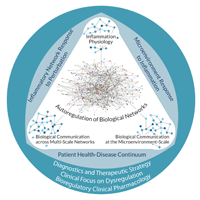Clinical Application Model
Bioregulatory Systems Medicine model conceptualizes a novel comprehensive, integrative and dynamic clinical approach for application of individualized medicine. In summary, the model:
- Describes the core elements of the Bioregulatory Systems Medicine.
- Offers an approach to assess the autoregulatory capacity of a patient.
- Can assist in formulating a more comprehensive treatment strategy.
- Can assist a clinician in prognosticating about a patient’s disease.
- Can assist in monitoring prescribed treatments.
- Proposes a methodological solution for real-world clinical research in individualized medicine by standardizing therapeutic approaches.
The model consists of ten emergent clusters that can be grouped into three larger thematic groups:
- The autoregulation clusters (Biological Communication across Multi-Scale Networks, Biological Communication at Microenvironment-Scale, Inflammation Physiology and Autoregulation of Biological Networks) describe the physiological autoregulation of biological networks, focusing on inflammation as a ”master regulator” of tissue homeostasis. The content of the autoregulation cluster group stresses the importance of communication in human biology both locally, on microenvironment-scale in tissues, and systemically, across multi-scale networks connecting all tissues and organs in the body.
- The dysregulation clusters (Inflammatory Network Response to Perturbation, Microenvironment Response to Inflammation and Patient Health-Disease Continuum) describe the human body’s response to perturbation. The content of this cluster group emphasizes the role of the inflammatory response as a regulatory mechanism defending against perturbations in biological networks. Non-resolving inflammation is indicative of autoregulation being unable to overcome perturbation, and consequently impairs biological communication on the microenvironment-scale causing morphologic changes in tissues. As a result of the interplay between the inflammatory network response and microenvironment response to inflammation, disease uniquely progresses along a health-disease continuum in every individual patient.
- The therapeutic clusters (Diagnostics and Therapeutic Strategy, Clinical Focus on Dysregulation and Bioregulatory Clinical Pharmacology) link a patient’s autoregulatory status with clinical decision making. While the Diagnostics and Therapeutic Strategy cluster emphasizes an integrative approach in clinical decision making depending on the assessed autoregulatory capacity of a patient, Clinical Focus on Dysregulation emphasizes the necessity to identify perturbed biological networks that are the underlying cause of a disease. The Bioregulatory Clinical Pharmacology cluster describes the properties of medications that are most useful in this context; e.g., based on natural combination chemistry.

Bioregulatory Systems Medicine Conceptual Clinical Application Model.
The model depicted in this figure represents three integrated levels as part of a single, unified entity. The fundamental core consists of the four autoregulatory clusters (white), enveloped by the layer of dysregulation clusters (light blue), which in turn is enclosed by final layer of therapeutic clusters (dark blue). In this way, the model communicates relevant fundamental underpinnings of human biology that result in the clinical picture observed in individual patients. The proper application of this clinical picture guides individualized clinical decision-making, which is based on underlying causes of disease. For a detailed explanation of this model, please refer to the text.
